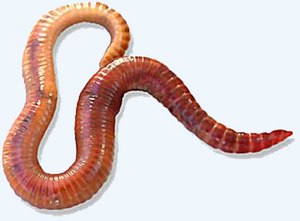Compost worm
| Compost worm | ||||||||||||
|---|---|---|---|---|---|---|---|---|---|---|---|---|

Compost worm |
||||||||||||
| Systematics | ||||||||||||
|
||||||||||||
| Scientific name | ||||||||||||
| Eisenia fetida | ||||||||||||
| ( Savigny , 1826) |
The compost worm ( Eisenia fetida ), also called dungworm or stink worm, is one of the most common types of earthworms (Lumbricidae) in Europe . It occurs mainly under rotting plants, for example in compost and manure heaps, and it is also common in meadow soils. It is also used in worm composting .
The genus Eisenia was named in honor of the Swedish naturalist Gustaf Eisen . The Latin addition f (o) etida means "smelly". For laypeople, it is difficult to distinguish Eisenia fetida from its sister species Eisenia andrei .
features
Eisenia fetida reaches a body length of about 60 to 120 millimeters, the diameter is 3 to 6 millimeters. When sexually mature, the body is divided into 80 to 120 segments; its front section is cylindrical and too weakly square towards the rear. The somewhat saddle-shaped clitellum comprises six to eight segments in the sexually mature worm, usually from the twenty-fourth or twenty-fifth to the thirty-second to thirty-fourth segment. The so-called puberty ridges (tubercula pubertatis) form narrow edges along the abdominal (ventral) border over about three segments.
E. fetida are hermaphrodites , but two specimens are necessary for reproduction, which mutually fertilize each other in the majority of matings.
Compost worms are very mobile compared to other earthworms and flee immediately if they are disturbed.
use
Compost worms are propagated in worm farms . Their excrement or extracts from it, the worm tea , are sold as organic fertilizer , the worms as bait for fishing and as fish feed .
literature
- Walter Rammner: Brehm's animal life in four volumes - first volume: Invertebrates , 2nd edition, Leipzig, 1952, p. 88
- Clive A. Edwards: Earthworm Ecology , 2nd Edition, CRC Press, 2004, ISBN 0-8493-1819-X
Web links
Individual evidence
- ^ Reginald William Sims, Brian M. Gerard: Earthworms. Synopses of the British Fauna, New Series 31. EJBrill London etc. (published for the Linnean Society of London and the Estuarine and Brackish Water Association), 1985. ISBN 90 04 07 582 8 , on pages 79-83.
- ^ AJ Reinecke & SA Viljoen (1991): A comparison of the biology of Eisenia fetida and Eisenia andrei (Oligochaeta). Biology and Fertility of Soils 11: 295-300.
- ↑ Jorge Dominguez, Alberto Velando, Manuel Aira, Fernando Monroy Uniparental reproduction of Eisenia fetida and E. andrei (Oligochaeta: Lumbricidae): evidence of selfinsemination , (2003) Pedobiologia 47, pp. 530-534
